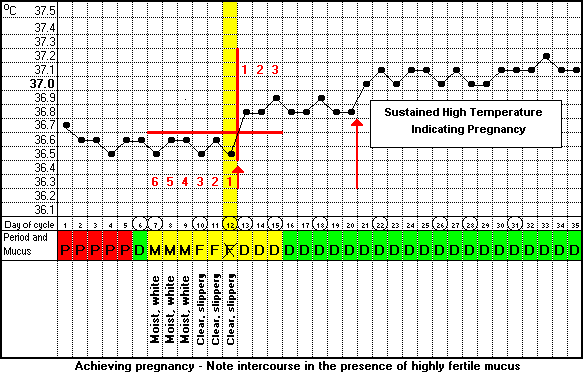The basal body temperature can help you know if you have ovulated and conceived in any given month. This type of temperature reading is taken for an entire month, every morning upon waking, and charted each day. As you go through your monthly cycle you will see the dips and raises in temperature as your hormones change. After conception the basal body temperature doesn’t drop until after delivery of the baby. So, the basal temperature can be a useful tool. This article will help you understand more about basal temperature charting, detecting changes in your cervical mucous, and how to note them on your chart.
Basal Temperature When Pregnant
Your basal body temperature is when your temperature is at its lowest point during the day. While you sleep, your basal body temperature drops and does not raise back to normal until you get moving around. You need to take your temperature with a mercury thermometer first thing when you wake up and before you get out of bed.
During the first phase of your cycle (menstruation) your basal temperatures will be pretty steady, then during ovulation you will notice a very slight drop in temperature, then goes back up after ovulation. If your temperature goes up over a certain point and stays elevated in the morning, there is a good chance you have conceived. Here is an example:
- Days 1 through 13 – Average basal temperature prior to ovulation may be: 97.0 to 97.5°F
- Day 14 (Approximate) – Drop in temperature around ovulation: 96.2 to 96.9° F
- Day 15 through 30 – Day after ovulation, temp goes back up: 97.0 to 97.5° F
- Conception – Basal temperatures will spike and stay high: 97.9 to 98.9° F
These are only examples of temperatures as every woman’s body responds differently to hormonal changes. You must chart your own temperatures for one full cycle to see what is normal for you. You will notice the beginning of the month that your temps stay in a certain pattern, with a slight drop around either day 12, 13 14, 15, or 16, and then rise again until your next period. When your period is ready to start, your temperature will drop slightly into the same numbers as the first week the previous month. If you conceived, you will not see that temperature dip, but it will stay slightly elevated as you notice your period is late. This is a helpful way to know if you have conceived in a given month. Charting you basal temperature, when pregnant, you’ll notice the difference as explained in the sample below:

Figure 1: Basal Temperature When Pregnant (Sample)

Figure 2: Sustained High BasalTemperature Means You Are Pregnant (Sample)
Charting Cervical Mucous
Your cervical mucous will also show changes during the different phases of your cycle. It will be blood from days 1 through 7 depending on how long your period lasts. Then it will slowly begin to change. From week two of your cycle it will change daily. Here are the different types of cervical mucus, by approximate times:
- Day 1 through 7 – Red/Blood (marked with an “R” or “B” on your chart)
- Day 8 and 9 – Dry or no mucus present (marked with a “D” on your chart)
- Day 10 and 11 – Sticky and feels tacky (marked with an “S” on your chart)
- Day 12 – Creamy and may look like a watery lotion (marked with a “C” on your chart)
Days 13 and 14 – Egg-white cervical mucus which is very thin, clear and stretches between your fingers. This is very fertile mucus to help the sperm reach the egg and only happens during ovulation (marked with “EWCM” on your chart).
On days 15 until your next period, your mucus may return to dry, sticky, or creamy again until your period starts. You may be fertile from the day EWCM mucus starts until after it goes away which could last up to a period of 3 to 7 days around the time of ovulation. Sperm can live in the body up to 7 days.
This technique should be used along with basal temperature charting to more accurately predict the time of ovulation and if pregnancy occurs. Here is a sample chart:

Figure 3: Cervical Mucus and Basal Temperature Chart When Not Pregnant (Sample)
How to Check Your Basal Temperature
After learning changes in basal temperature when pregnant, here is how you check your basal temperature throughout the cycle:
1) The day that you start your period, start your chart as day one. Try to take your temperature that morning and still log the temp, plus chart your cervical mucus as “R” or “B” just to get used to filling in the blanks every day.
2) Take your temperature every morning before you move too much or get out of bed. Check your cervical mucus after your period ends by placing a finger all the way up to your cervix and removing some. Rub it between your fingers and see if it is sticky, creamy, or pulls apart like egg whites. Chart your temp and your mucus. Also note on the chart when you have intercourse.
3) Connect all the dots on your chart and then look at the end of your cycle when you ovulated, when you had intercourse, and if your temps are staying elevated or if you notice a slight drop before your next period. After one or two cycles, you will know when your ovulation days are and if your period will start or if you should take a pregnancy test.
One way to use basal temperatures when pregnant, is to look back a few days after ovulation. You will notice another very slight drop in your temperature. This is known as the “implantation dip” and another sign of very early pregnancy. Some people will have a positive pregnancy test shortly after this dip.






